The New Story
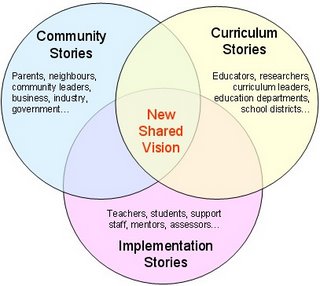 David Warlick
David Warlick has posted on the
Types of New Stories we need to be telling as we implement 21st century curriculum. He has set up a
wiki and invited educators to begin "hacking" some new stories.
I've already taken the liberty of hacking
David's graphic to include 'shared vision' - a suggestion from a comment on his post - as well as changing 'reform stories' to 'curriculum stories' because I think we are involved in more than re-forming curriculum - there is a necessary degree of
trans-formation going on as we move beyond traditional structures and processes. I've also tweeked some of the words to suit a local audience.
Perhaps a more extreme version of telling a new story is
'branding'. I've been trawling so-called "21 st century educational institutions" on the web to find some examples. I've mashed a few to get the following brands, slogans or banners:
- Bringing knowledge to life
- Learning for life
- Community of inquiry
- The world has changed. So have we.
- School X: A learning community
- School X: Wired for learning (perhaps that should be "Wireless for learning" :-)
- School X: Your gateway to the world
- School X: Where learning comes to life
- School X: Building your confidence
- Follow your interests… Discover your dreams…
- Connecting learners with opportunities
- Your learning – Our future
- Got plans? We’ll show you how!
Any other ideas?
I also found a couple of interesting blogs on the subject - lots of $$$ and pitfalls here!
Marketing to College StudentsInside Higher Ed - Gaglines - with a link to a
database with 150 taglinesWhisperLabels: curriculum, storying, transformation
Literacy of Cooperation

Just came across a great poster 'Technologies of Cooperation Map' outlining (defining?) Web 2.0 (without mentioning the word) on the Literacy of Cooperation resources page. Certainly gives a big picture!
Also some interesting videos and links on 'cooperative technologies', 'emergent democracy' and 'collective intelligence' including presentations looking at the creation of civic spaces and motivators for cooperation such as saving the world and love...
Link via Alex Steffan at WorldChanging
Labels: collaboration, communication, literacies
Knowledge Metaphors
How we see 'education', 'schooling', 'learning', 'teaching' and 'assessment' has much to do with how we see knowledge. Here is a page that my wife
Sue put together that nicely illustrates some different ways of seeing knowledge...

Knowledge gained from different disciplines is quite separate and can’t be easily integrated.

You can build knowledge from different disciplines, but some disciplines are more foundational than others. To what extent is knowledge restricted by its foundations?
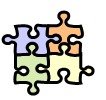
Knowledge from different disciplines fit together like a jigsaw puzzle.
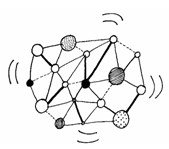
Integrating knowledge from different disciplines creates emergent understandings, new perceptions and new questions. Do our questions create the universe to be discovered?

Knowledge in one area is a reflection of the whole. Can you know the whole through complete knowledge of the part?
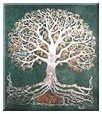
Knowledge is like a tree… mathematics explains physics explains chemistry explains biology explains love. Is there knowledge to be found outside the branches of the tree?

Knowledge is nested: Knowledge at each level includes and transcends earlier levels.
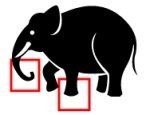
Each discipline illuminates a facet of the 'truth'. We need to bring in all perspectives to see the whole. What perspectives might be missing?
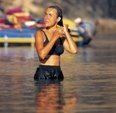
Knowledge is like a river… it moves and changes. If you dip your toe into the river tomorrow, you will experience a different river from today. There is no truth which stands still to be found.
No dout there are many other metaphors...
4 Quadrant Integral Theory might suggest all the above have some validity... eg knowledge gained from methods of inquiry in one quadrant should be applied very cautiously to other quadrants (buliding blocks)
and knowledge that omits any quadrant gives only a partial view of 'reality' (elephant)
and each quadrant contains parts which are wholes - holons (nested)
and each quadrant is evolving with no end in sight (river)...
Graphics: MS Clipart Online
Labels: integral, learning
Flat Classrooms
I've been following
David Warlick's exploration of the concept of
Flat Classrooms.
Yesterday's post responded to a comment by
David Davies that asked.. "to what extent do you think students in the not-so-flat classroom are not curious, not self-directed, uncommunicative, etc?" David responded by saying that "there is nothing new here, that you haven't already heard..." but I'm not so sure...
I agree that there may be nothing new in the sense that we have talked about these issues before and that students have always been learners. BUT I don't think we have talked much about systemic solutions that address some of these issues by looking at our underlying values and assumptions. Educational provision has rarely been built on conversations between "student and teacher, learner and curriculum, classroom and the world" that David is asking for in the flat classroom.
And I don't think we are seeing much of the kind of curiosity, self-direction and communication that we as a nation (Australia) now require of students - particularly among the more traditionally "academically educated" students. Government, business, community and higher education - who are looking at the economic and social realities of living and woking in today's globalised technology rich world - are telling us that students:
- are good at following "recipes learned at school" that provide solutions to closed problems,
- are curious to learn more within known boundaries and
- can communicate what they know.
BUT
- they are not good at open-ended problems
- they ask few questions
- they don't know what they don't know - and are over confident about what they think they do know
- they don't collaborate very well
- they are not innovative - particularly outside disciplinary boundaries
I also think there is much more to explore using this "flatness" metaphor... We need to question how much students need to climb disciplinary ladders of knowledge and skills based on assumptions about developmental stages and academic hierarchies.
Students are often told that they have to "master the basics" before doing more interesting and contemporary things within a discipline and across disciplines. Unfortunately that process often takes 12 or more years and many (most?) don't stay in education long enough to be inspired by the genuine communities of practice/inquiry that dealing with today's knowledge and issues at the leading edge. We need some "flatness" here as well.
Of course some students can see this for themselves. They are some of the really self-directed learners who learn beyond the classroom walls. Here is how one science student described his learning to me:
"As far as my reading goes it's generally the Internet or magazines (national geographic and new scientist) or books like brief history of time and universe in a nutshell (illustrated edition - much easier to read than the original) I have NEVER had a good science teacher but that probably has more to do with me than them!
I would be one of those @#$#@ students - like in grade seven we had to name one of the 'three' states of matter and she mistakenly picked me and when I said plasma she rolled her eyes and sighed.
That's how I feel every time I'm forced to learn something wrong, even in year 11 & 12 (last year) they teach us the 'model atom' and you just think “wrong” - friction “wrong” - and do stuff with your friends [till it comes to exam time]. The best advice I got was play dumb – don’t give the right answer - give the answer according to what you've been 'taught'.
That's why I could not teach physics because I'd want to explain the quantum flux to the kindergarten kids. Instead I'm [leaving the state] so I can get into the cutting edge stuff…"
Labels: 21stCentury, assessment, collaboration, curriculum, engagement, global, learning, teaching
Blogs Away...

I received
Will Richardson's Blogs, Wikis, Podcasts... 2 days ago and found it to be such an informative and easy read that I'm ordering a few more to spread around campus.
In the meantime I've prepared an introduction for teachers - here are the slides (the narrated version is too big to link) showing how these Web 2.0 apps relate to our new curriculum. We have a whole staff session on these after Easter...
 I've linked each of the tools to our new Values, Purposes and curriculum organisers. Since the curriculum was designed to meet the needs of 21st century learners it's not surprising that many of the tools they are using easily link to the new curriculum.
I've linked each of the tools to our new Values, Purposes and curriculum organisers. Since the curriculum was designed to meet the needs of 21st century learners it's not surprising that many of the tools they are using easily link to the new curriculum.
On my school blog I've been experimenting with different kinds of posts modelling some things for students at the same time. This is the first year I have pushed blogs strongly with my classes - they can opt out but most are posting. For some, posting has come easily while others have moved tentatively from one word "Hi" to a sentence and more recently to paragraphs.
Some highlights have been students receiving international comment 5 mins after posting and one girl who danced excitedly around the room doing high-fives after she had 30 people read a poem she had posted. Evidence of higher order thinking and reflection in their blogs is still sparse but I'm optomistic I'll see more after the Easter break.
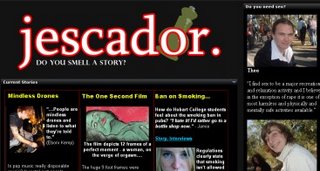 Something that has worked well has been an online (campus-only) publication 'jescador' where my journalism class used our portal (MS Sharepoint) to glue together headers from stories posted in their blogs. In this way the publication went out as a whole while preserving the ability for readers to comment on individual stories and for the authors to keep a tally on the number of views for each story. Pretty neat.
Something that has worked well has been an online (campus-only) publication 'jescador' where my journalism class used our portal (MS Sharepoint) to glue together headers from stories posted in their blogs. In this way the publication went out as a whole while preserving the ability for readers to comment on individual stories and for the authors to keep a tally on the number of views for each story. Pretty neat.
Labels: collaboration, communication, ICT tools, learning
 David Warlick has posted on the Types of New Stories we need to be telling as we implement 21st century curriculum. He has set up a wiki and invited educators to begin "hacking" some new stories.
David Warlick has posted on the Types of New Stories we need to be telling as we implement 21st century curriculum. He has set up a wiki and invited educators to begin "hacking" some new stories.









 I received
I received 
 Something that has worked well has been an online (campus-only) publication 'jescador' where my journalism class used our portal (
Something that has worked well has been an online (campus-only) publication 'jescador' where my journalism class used our portal (


